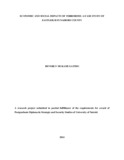| dc.description.abstract | Since the 1998 attack, Kenya has continued to witness more terrorist attacks and the problem
has been compounded further following its incursion into Somalia in October 2011. Kenya’s
military presence in Somalia has seen it became a soft target for revenge attacks by
insurgency groups like Al-shabaab with the effects being felt in the economic, social,
political and religious facets of the affected parts of the country. Among the most affected
regions in the country are Garissa, Mandera, Mombasa, Eastleigh and Lamu. This study
sought to assess the economic and social impacts of terrorism in Eastleigh within Nairobi
County. The study’s focus on Eastleigh was informed by the numerous terrorist attacks
perpetrated in the area since December 2011 and the fact that it is an economic hub within
Nairobi. The study was guided by two objectives; exploring the effect(s) of terrorism on
trading activities in Eastleigh and finding out the impact of terrorism on social interactions
among Eastleigh residents. The study findings in terms of economy were; there was a
reduction in investment opportunities as some business people closed shop and relocated to
other areas in Nairobi, employment levels declined particularly employment of casual
laborers who opted to move to neighboring markets such as Gikomba and Kariokor, the cost
of living rose due to an increase in the price of basic commodities and operational costs for
businesses augmented because business people were forced to boost security procedures to
protect their property and customers. Socially, the respondents stated they had adjusted their
lifestyles with some stating they had reduced visits to social places such as pubs, shopping
malls and restaurants and others stated they knew of people who had relocated to other areas
in Nairobi. In terms of attendance of religious functions, immediately after an attack there
was a decline in attendance of church/mosque services by faithfuls but after a few weeks the
numbers picked up and services resumed normalcy. The study was qualitative in nature and
data was drawn from both primary and secondary sources. The primary data was gathered
using Focus Group Discussions (FGDs) and in-depth interviews with its main tool of data
collection being an interview guide. The study had two FDGs and four in-depth interviews
and data was analyzed using thematic analysis. | en_US |



